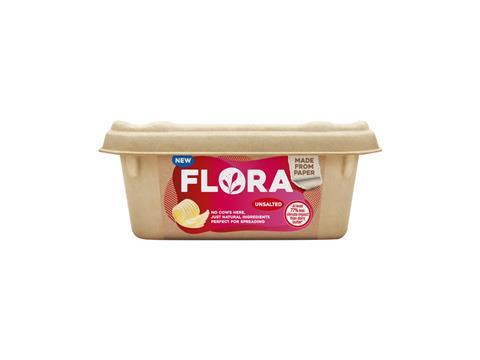
Upfield, one of the world’s largest producers of plant-based butters and spreads, recently revealed that a large part of its portfolio would be transitioning away from plastic tubs to start using plastic-free, paper-based ones. Karina Cerdeira, packaging development director at Upfield, tells us more about why the company made this decision – and its potential effects.
For our readers who may have missed the original announcement, could you give a brief overview of this new innovation?
At Upfield, we are thrilled to launch our plastic-free paper tubs for plant-based spreads and butters, whilst taking a significant step towards meeting our target to reduce plastic packaging by 80% by 2030.
As a global leader in plant-based food, we take our responsibility to make a positive impact on the world seriously. We know the issue of plastic waste is one of the most critical facing our planet so we’re working to remove plastic from our products.
The roll-out of the new, category-first paper tubs began in Austria with the Flora Plant brand in late 2023. The intent is for the UK and Netherlands to follow suit in early 2024, across household brands including Blue Band and Rama.
Why was the decision made to pivot away from the previous format, and why was fibre selected as the alternative?
Globally, 40% of all plastic produced is for packaging that is used once and then discarded. Our move toward paper removes millions of items of avoidable plastic waste from the environment and importantly, embraces a renewable and nature-based packaging solution over one that relies on fossil inputs.
Please could you run us through the construction of the pack, its key functionalities, the materials it uses, and its barrier properties?
Our new rigid paper tubs are the result of four years of investment, innovation, and testing to find a solution that works for an oil-based product but also for consumers, retailers and most importantly the planet. They are waterproof, oil-resistant, recyclable in local paper waste streams and use fibres that are PEFC-certified.
We are working with wet-molded fibre technology that allows us to coat each fibre individually, creating a strong bond between the fibres and ensuring there is no space between them – giving strength to the packaging. We can confirm that all components that make the tub are absolutely food-grade standard and pass our stringent quality and safety checks.
The design is totally consumer-centric, the key was to ensure that we could meet the needs of the consumer by focusing on the functionalities the consumer is used to when with plastic packaging but adapting to the new material and technology.
How does this version compare to the previous one in terms of recyclability?
Both tub versions are recyclable, but in general, paper is more widely recycled than plastic. Our new paper tubs have received recyclability Class A certification from leading European recycler Circpack by Veolia, which means they are fully compatible with recycling processes. The only requirement is that they are washed and rinsed first which is clearly indicated on the labels – just like most recyclable packaging.
And in terms of overall climate impact and carbon emissions, if an LCA has been undertaken, how does this version compare to the plastic version?
We have undertaken a preliminary LCA study which has not yet been peer-reviewed but initial results, when taking into consideration all elements that are measured as part of an LCA, for some markets and depending on the end of life for the packaging, the LCA shows the climate impact is equivalent between our paper tub and the plastic predecessor.
If you liked this article, you might also enjoy:
The L’Oréal approach to packaging sustainability
The way we talk about plastic needs to change – here’s how to get it right
What steps is Apple taking to make its packaging more sustainable?




















No comments yet